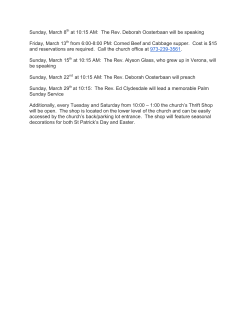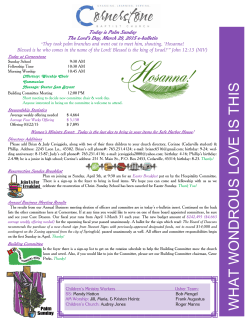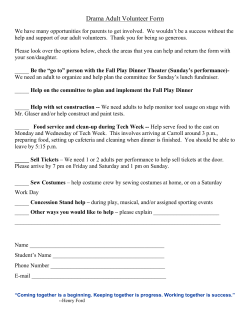
March 2, 2015 - International Society of Fire Service Instructors
2015 ISFSI Membership Social Premier Networking Event for ISFSI Members April 21, 2015 Mo's A Place For Steaks Indianapolis, IN ISFSI Membership Social ---Tuesday, April 21, 2015 Every year on Tuesday Evening during FDIC, hundreds of ISFSI members gather for an evening of networking. Food, beverages and music will be available. Bring a guest, and if they become an ISFSI member at the door, receive a free "Winners Train, Loser's Complain ISFSI t-shirt". Event Sponsored by Honeywell and Scott Safety SAFER and FP&S Panelist Request The success of the Fire Prevention and Safety (FPS) Grants and the Staffing for Adequate Fire and Emergency Response (SAFER) Grants depend upon volunteer peer reviewers from fire service organizations. The evaluators for the fiscal year (FY) 2014 FPS and SAFER Grants will meet simultaneously in the same location. The following will be reviewed: Fire Prevention and Safety, Fire Prevention and Safety Research and Development, and Staffing for Adequate Fire & Emergency Response applications. The evaluation sessions are planned for a location to be determined in the Washington/Baltimore/Northern Virginia metropolitan area from May 4 – May 8, 2015. Evaluators should plan to arrive the day before the evaluation period and return home the afternoon of the final day of the evaluation period. The AFG Program will cover travel costs such as transportation, food, and lodging. Ground transportation will also be provided between the airport and the panel location. Panelists will be contacted to discuss the necessary travel arrangements and reimbursement. No salary or compensation other than travel expenses will be provided for volunteers. If you are interested in participating in the upcoming peer review sessions, please reply to Jamie Lacy with the following information no later than, Friday, March 20, 2015 at 5:00 p.m. Your responses can be directed to jamie.lorello@isfsi.org. Grant Program to evaluate (Please indicate FPS, RD, or SAFER) Full Name Organization Name Organization Represented (Career, Volunteer, Combined) Position/Title Mailing Address Day AND Evening Phone Email Address Specific experience with working in a Fire Prevention capacity Months/Years of experience in each of the Fire Prevention capacity Research and Development Criteria Required: Clinical Areas of study: Behavioral studies, Social science and cultural research, and Physiological and medical research activities Technological areas of study: Study of fire phenomena inside and outside structures; Product development to enhance firefighter situational awareness and effectiveness; and The use of fire protection strategies and products to minimize the development of fire hazards Other area of study: Data collection that has aimed to determine the predictors and correlates for incidents pertaining to fatal and non-fatal injuries; Dissemination and implementation research; and Preliminary studies Staffing for Adequate Fire and Emergency Response Criteria Required: Specific experience working in a Fire Prevention capacity: Hiring of firefighters, Recruitment and retention of firefighters, National Firefighter Safety Initiatives and NFPA 1710 and 1720 Months/years of experience in each of the selected SAFER capacities: Education/Training and Job Experience (Specifically SAFER related) ISFSI does not make the final selection for the review sessions. You will be contacted by AFG if you have been selected. Principles of Modern Fire Attack: SLICE-RS Program View the full schedule of classes here. If you are interested in hosting the program, please contact Leigh Hubbard by email at leigh.hubbard@isfsi.org. Training Tip: The Sunday Paper Sundays in the firehouse at my department are the best days of the week: Sunday brunch, football, and some down time from the hustle and bustle of all the other “business” days. However, remember that to truly be effective as a company, every day (even Sunday) should be a training day. At least for a little bit… One of the most simple and cost-effective training aids for a company-level drill on a Sunday morning is the local newspaper. Beyond headlines and sports scores, the company officer should focus in on one particular area: the real estate section. Most Sunday newspapers, either for your own city/town or for the nearest major metropolitan area, have a real estate section filled with property transaction records, street names, pictures of houses, interior layout diagrams, apartment building descriptions, and other items of interest that can be turned into a simple but effective company-level review. And the best part is, these are REAL houses in YOUR first-due jurisdiction. These aren’t theoretical houses and potential interior layouts that a training officer dreams up to practice “reading” a building. By using the local real estate section, you can provide your firefighters with realistic scenarios that you could literally respond to that same day. Here are some quick tips for using the Sunday paper: Start with streets. Most real estate sections will have a list of property transactions grouped by jurisdiction. Find your city or township, and even directly neighboring areas, and have a “street school” session with your crew. What’s the best route to this address from the firehouse? What if XYZ Street is closed on your route, then what’s the best alternate route? What’s the quickest run to the typical hospital from that location? How about for a transport to Children’s Hospital or some other specialty facility? Next, flip to the individual real estate advertisements (the typical ones with a small picture and a paragraph or so worth of description). Do some “street school” again to get to the address. Now, once you’re there, sizeup the structure. This is a great way to practice reading the building. How many bedrooms? Where are they? How many bathrooms? Where are they? Where’s the kitchen/dining area? Where are the stairs? Is there a basement? Approximate square footage? Using key exterior indicators such as number of floors, location of garage, and placement/size of windows, you should be able to get a reasonable idea of the interior layout. Then, simply read the description below the picture and see how close you were! From there, the possibilities are almost endless. For example, use the home size to practice calculating fire flow estimations (L x W / 3, etc.). If you’re in a rural area, figure out where the nearest fill site would be for a water shuttle operation. Take it a step further and determine the number of tankers/tenders (based the water capacities of your mutual aid partners) that would be needed to sustain the required fire flow using variations in a simple Tanker Deliver Rate formula GPM = Capacity in gallons / (Fill time + travel time + dump time + travel time) Use the different types and ages of houses throughout the real estate section to spark a discussion on modern vs. legacy building construction and the dangers of lightweight wood trusses, gusset plates, engineered I-beams, etc. Discuss interior furnishings and Heat Release Rates (HRR) of modern fuels. Discuss tactical options based on various fire/smoke conditions encountered upon arrival. Quiz your crew on search priorities and likely victim locations. The list can go on and on… So take your next Sunday morning coffee table discussion and toss in some realistic scenarios for actual houses that really exist in your own first-due jurisdiction. Drawing pictures on the white board or using fire photos from a trade magazine is ok, but nothing matches the direct impact of looking at your own buildings that you could respond to on today’s shift. Keep the training coming hard, and stop at nothing to make your engine company the best it can be. This months ISFSI Contributing Author is Lieutenant Brad French with Dayton Fire Department in Ohio. He is a 15 year member of the fire service and holds a degree in Fire Science and Fire Administration. He is a lead instructor at the Dayton Fire Department Training Center and Sinclair Community College as well as an instructor for the ISFSI Principles of Modern Fire Attack program. Contact Brad at bfrench@iaff136.org. Attending FDIC 2015? Here are a few sessions you do not want to miss by ISFSI Members! Steven Hamilton, Lieutenant Fort Jackson Fire Department “Responding To and Preparing for Acts of Violence” 4-hour workshop on Monday, April 20 8:00 a.m. Bob Atlas, Battalion Chief Contra Costa County Fire “11 Essentials of an Excellent Company Officer” Wednesday, April 22 3:30 – 5:15 p.m. John Murphy, JD, MS, PA-C, EFO, Deputy Fire Chief (Ret) Murphy Law Group “Training Liabilities” Thursday, April 23 Mark Emery, President Fire Command, LLC “YES + YES + YES = Offensive” Thursday, April 23 Al Schlick, Division Chief/Director of Training Wauconda Fire District “Required Training: A Guide for the Training Officer” Tuesday, April 21 8:00 a.m. – 12:00 p.m. Dr. Richard Gasaway, Fire Chief (Ret) Gasaway Consulting “Situational Awareness Barriers: Lightening Round” Wednesday, April 22 3:30 – 5:15 p.m. Eddie Buchanan, Division Chief Hanover Fire-EMS Department "Leading with Attitude! Secrets of the Rock Star Engine Company!" Steve Pegram, President ISFSI "Principles of Modern Fire Attack" This is was composed by ISFSI members who notified ISFSI staff about teaching at FDIC. If you are a member, and are teaching at FDIC and would like to be included in this list, please email Jamie Lacy at jamie.lorello@isfsi.org. Click here to view all of the FDIC 2015 training sessions.
© Copyright 2025









